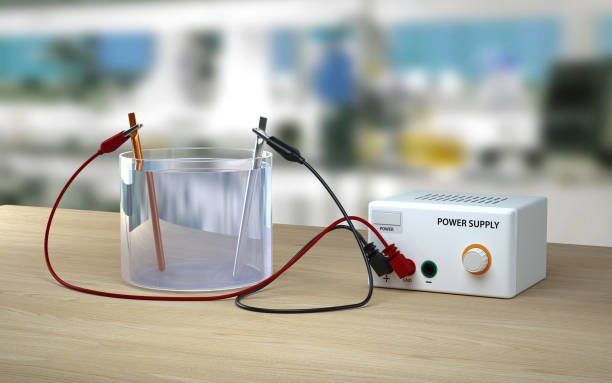Electrolysis is a fascinating scientific process used across various industries and educational settings. If you’ve ever asked, “What name is given to the substance that is broken down during electrolysis?” — you’re not alone. The answer lies in fundamental chemistry, and in this article, we’ll break it all down for you.
Profile Biographie Table
| Field | Details |
| Term of Interest | Electrolyte |
| Scientific Category | Chemistry (Electrochemistry) |
| Process Involved | Electrolysis |
| Breakdown Product | Ions (Cations and Anions) |
| Discovered By | William Nicholson and Anthony Carlisle (1800) |
| Common Examples | Sodium chloride solution, copper sulfate, etc. |
| Applications | Metal extraction, electroplating, water splitting |
| Electrolyte States | Molten or in aqueous solution |
| Ion Movement | Cations → Cathode, Anions → Anode |
What Is Electrolysis?
Electrolysis is a chemical process in which electrical energy is used to drive a non-spontaneous reaction. It involves passing an electric current through a liquid or molten substance to cause chemical changes.
The Substance Broken Down During Electrolysis: The Electrolyte
The name given to the substance that is broken down during electrolysis is “electrolyte.”
An electrolyte is a substance that contains free ions and can conduct electricity. In electrolysis, it undergoes decomposition when an electric current is passed through it.
How Electrolytes Work in Electrolysis
Electrolytes typically exist in aqueous (water-based) solutions or molten states. Once electricity is introduced:
- Cations (positively charged ions) move toward the cathode (negative electrode).
- Anions (negatively charged ions) move toward the anode (positive electrode).
These ions then undergo reduction and oxidation reactions respectively, resulting in new substances forming.
Types of Electrolytes Used
Different types of electrolytes can be used depending on the purpose of electrolysis:
- Acidic Electrolytes: Sulfuric acid, hydrochloric acid.
- Basic Electrolytes: Sodium hydroxide, potassium hydroxide.
- Salt Electrolytes: Sodium chloride (common salt), copper sulfate.
Each of these substances, when dissolved in water or melted, releases ions essential for conduction.
Example: Electrolysis of Water
Water (H₂O) itself is not a strong conductor. However, when a small amount of sulfuric acid (electrolyte) is added, it ionizes into H⁺ and SO₄²⁻ ions. During electrolysis:
- Hydrogen ions (H⁺) are reduced at the cathode to form hydrogen gas (H₂).
- Hydroxide ions (OH⁻) are oxidized at the anode to produce oxygen gas (O₂).
Thus, the electrolyte (dilute sulfuric acid) facilitates the breakdown of water.
Example: Electrolysis of Sodium Chloride Solution
Another common example is the electrolysis of brine (a concentrated solution of sodium chloride):
- At the cathode: Na⁺ + e⁻ → Na (metal)
- At the anode: Cl⁻ → ½ Cl₂ + e⁻ (gas)
The electrolyte (sodium chloride) is broken down into sodium and chlorine.
Components of Electrolysis System
Every electrolysis setup requires three main components:
- Electrolyte – The substance being broken down.
- Electrodes – Conductive rods (typically graphite or metal).
- Power Source – Provides the electric current necessary to start the reaction.
Redox Reactions During Electrolysis
Electrolysis involves two simultaneous reactions:
- Reduction at the Cathode: Gain of electrons (e.g., H⁺ → H₂)
- Oxidation at the Anode: Loss of electrons (e.g., Cl⁻ → Cl₂)
These redox reactions are essential for the breakdown of the electrolyte.
Industrial Applications of Electrolyte Decomposition
Understanding electrolytes is crucial because electrolysis is used in:
- Metal Extraction: Aluminum, magnesium from molten salts.
- Electroplating: Coating metals like gold, silver.
- Chlor-Alkali Process: Producing chlorine and caustic soda from brine.
- Water Splitting: Generating hydrogen fuel.
All these rely on the electrolyte as the decomposed substance.
Common Electrolytes and Their Products
| Electrolyte | Cathode Product | Anode Product |
| Sodium chloride (NaCl) | Sodium (Na) | Chlorine (Cl₂) |
| Copper sulfate (CuSO₄) | Copper (Cu) | Oxygen (O₂) |
| Water with acid (H₂SO₄) | Hydrogen (H₂) | Oxygen (O₂) |
| Molten lead bromide | Lead (Pb) | Bromine (Br₂) |
Why Is It Called an Electrolyte?
The term “electrolyte” is derived from the Greek words:
- “ēlektron” – meaning amber or electricity.
- “lysis” – meaning to loosen or dissolve.
So, it literally translates to “a substance that dissolves under electricity.”
Misconceptions About Electrolytes
Some common misconceptions include:
- Water is always an electrolyte – Not true. Pure water is a poor conductor and needs an additive.
- Electrolytes are always liquids – False. They can be molten solids too.
- All electrolytes are safe – Incorrect. Many are corrosive or hazardous.
Key Takeaways
- The electrolyte is the substance broken down during electrolysis.
- It must contain free-moving ions to conduct electricity.
- Cations go to the cathode, anions to the anode.
- Electrolysis plays a vital role in many industrial processes.
Read More: RandomGiantNet – A Deep Dive into the Mysterious World of Digital Giants
Conclusion
So, what name is given to the substance that is broken down during electrolysis? — It is electrolyte. This seemingly simple term is at the heart of one of chemistry’s most powerful processes. Whether you’re a student, educator, or industry professional, understanding the role of the electrolyte helps unlock everything from basic chemical principles to cutting-edge energy solutions.
